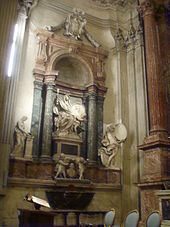| San Giovanni dei Fiorentini | |
|---|---|
| Basilica di San Giovanni Battista dei Fiorentini | |
 The façade of San Giovanni The façade of San Giovanni | |
| Click on the map for a fullscreen view | |
| 41°53′59″N 12°27′54″E / 41.8997°N 12.465°E / 41.8997; 12.465 | |
| Location | Rome |
| Country | Italy |
| Denomination | Catholic Church |
| Tradition | Latin Church |
| Website | sangiovannibattistadeifiorentini |
| History | |
| Status | minor basilica titular church regional church |
| Architecture | |
| Architect(s) | Giacomo della Porta Jacopo Sansovino |
| Architectural type | Church |
| Style | Baroque |
| Groundbreaking | 1523 |
| Completed | 1734 |
| Clergy | |
| Cardinal protector | Giuseppe Petrocchi |
The Basilica of San Giovanni dei Fiorentini ("Saint John of the Florentines") is a minor basilica and a titular church in the Ponte rione of Rome, Italy.
Dedicated to St. John the Baptist, the protector of Florence, the new church for the Florentine community in Rome was started in the 16th century and completed in the early 18th, and is the national church of Florence in Rome.
It was lavishly decorated with art over the 16th and 17th centuries, with most commissions going to Florentine artists.
History


Julius II's successor, the Florentine Pope Leo X de' Medici (1513-1521), initiated the architectural competition for a new church in 1518 on the site of the old church of San Pantaleo. Designs were put forward by a number of architects, among them Baldassare Peruzzi, Jacopo Sansovino, Antonio da Sangallo the Younger and the painter and architect Raphael. The dominant initial ideas were for a centralised church arrangement.
Sansovino won the competition but the building construction was subsequently executed by Sangallo and Giacomo della Porta.
In 1559, Michelangelo was asked by Cosimo I de' Medici, Duke of Tuscany, to prepare designs for the church and he presented a centralised church arrangement but this was not adopted.

The main construction of the church was carried out in 1583-1602 under the architect Giacomo della Porta based on the Latin cross arrangement. Carlo Maderno took over from 1602 to 1620, and directed construction of the dome and the main body of the church. However, the façade, based on a design by Alessandro Galilei, was not finished until 1734.
In 1623-24 Giovanni Lanfranco produced paintings for the Sacchetti chapel.

In 1634, the Baroque painter and architect Pietro da Cortona was asked by the Florentine nobleman Orazio Falconieri to design the high altar. Drawings for the altar and its setting and a model were prepared but the project was not carried out. Cortona's ideas for the choir included windows hidden from the view of the congregation that would illuminate the altarpiece, an early example of the Baroque usage of a "hidden light" source, a concept which would be much employed by Bernini. Some twenty to thirty years later, Falconieri resurrected the choir project but gave the commission to the Baroque architect Francesco Borromini, who changed the design to allow for the burial of Orazio's brother, Cardinal Lelio Falconieri. After Borromini's death in 1667, the work was completed and partly modified by Cortona and, on his death in 1669, by Ciro Ferri, Cortona's pupil and associate.
Notable people
Ordinaries

- Joseph-Charles Lefèbvre (appointed 28 March 1960 - died 2 April 1973)
- Juan Carlos Aramburu (appointed 24 May 1976 - died 18 November 2004)
- Carlo Caffarra (appointed 24 March 2006 - died 6 September 2017)
- Giuseppe Petrocchi (appointed 28 June 2018)
Musicians
- Giovanni Marciani, maestro di cappella from 1645-1659
Burials
Francesco Borromini is buried under the dome.
Carlo Murena, architect
References
- Heydenreich, L.; Lotz, W. (1974). "Architecture in Italy 1400-1600". Pelican History of Art. p. 195-196.
- "Chiesa di San Giovanni Battista dei Fiorentini". Lonely Planet. Retrieved 7 August 2015.
- Heydenreich & Lotz, 1974, p. 257
- Guide Rionali di Roma , Rione V, Ponte, Parte IV, 1975, p.16 (in Italian)
- "Giovanni Lanfranco". Matthiesen Gallery. Archived from the original on May 15, 2006. Retrieved 8 March 2015.
- Blunt, Anthony. Guide to Baroque Rome, Granada, 1982, p.51; Merz, Jorg Martin. Pietro da Cortona and Roman Baroque Architecture, Yale, 2008, pp 87-91
- Merz, J.M. 2008, p 90-91
- David M. Cheney (4 August 2018). "San Giovanni Battista dei Fiorentini (Cardinal Titular Church)". Catholic-Hierarchy.org. Retrieved 9 August 2018.
- Gloria Rose (2001). "Marciani, Giovanni". Grove Music Online. Oxford University Press. doi:10.1093/gmo/9781561592630.article.17742.
- "San Giovanni dei Fiorentini". Rome Sights. Fodor's. Retrieved 20 January 2013.
- "Treccani.it - Murena, Carlo".
Further reading
- Emilio Rufini, S. Giovanni de' Fiorentini (Rome: Marietti, 1957).
- Paolo Portoghesi, Roma Barocca (Rome: Laterza, 1966).
- Luigi Lotti, S. Giovanni dei Fiorentini (Rome: Alma Roma, 1971).
External links
- Lucentini, M. (31 December 2012). The Rome Guide: Step by Step through History's Greatest City. ISBN 9781623710088.
[REDACTED] Media related to Church of San Giovanni Battista dei Fiorentini at Wikimedia Commons
| Preceded by San Giovanni a Porta Latina |
Landmarks of Rome San Giovanni dei Fiorentini |
Succeeded by Santi Giovanni e Paolo al Celio |
| Francesco Borromini | |
|---|---|
| Churches and religious buildings |
|
| Secular buildings |
|
| Other works |
|
| Related |
|
| Pietro da Cortona | |
|---|---|
| Buildings |
|
| Paintings |
|
| Tapestries |
|
| Related |
|
- Basilica churches in Rome
- Titular churches
- 16th-century Roman Catholic church buildings in Italy
- Religious buildings and structures completed in 1734
- Baroque architecture in Rome
- National churches in Rome
- Churches of Rome (rione Ponte)
- Alessandro Galilei buildings
- Francesco Borromini buildings
- Pietro da Cortona buildings
- Carlo Maderno buildings
- Jacopo Sansovino buildings